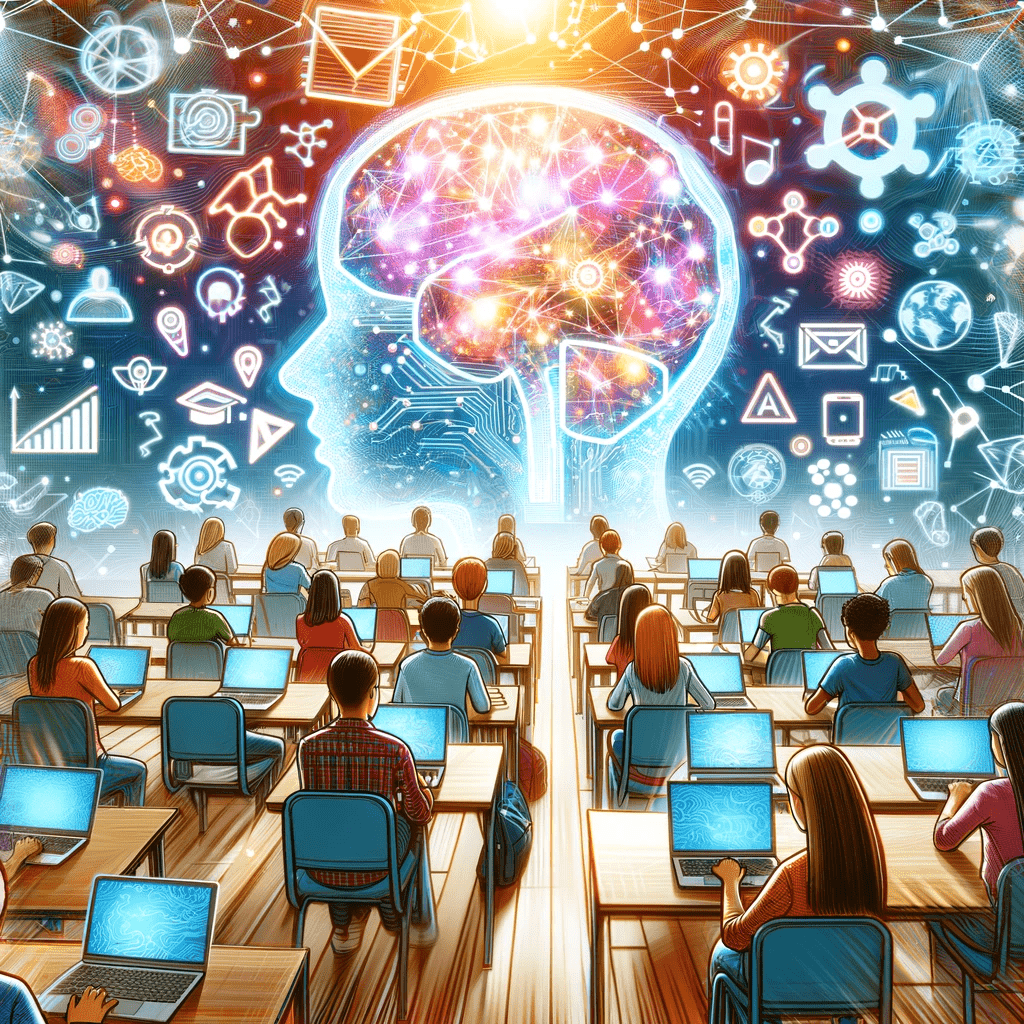I. Introduction
Definition of Educational AI Tools
In today’s digitally-driven world, Educational AI Tools are revolutionizing the landscape of learning and teaching. These tools, powered by artificial intelligence (AI) and machine learning, offer dynamic, personalized education experiences. By harnessing the capabilities of AI in Education, these tools create smart learning environments that adapt to individual student needs. AI-Powered Learning Platforms are not just digital interfaces; they are intelligent systems that provide data-driven learning solutions, enhancing the overall technology in the classroom.
Importance of the Topic
The integration of AI for Student Success and the broader digital transformation in education is a pivotal topic. As we navigate through the rapid advancements in Educational Technology Trends, understanding the role and impact of these AI tools becomes crucial. It’s not just about the technology; it’s about shaping the future of education to be more inclusive, efficient, and effective.
Thesis Statement
Our exploration delves into the multifaceted world of Educational AI Tools, highlighting their evolution, types, benefits, and challenges. We’ll showcase real-world case studies, best practices for implementation, and forecast future trends, emphasizing AI ethics in education. This comprehensive view aims to illustrate the transformative power of AI in creating student-centric learning experiences, thereby fostering a more adaptive and engaging educational ecosystem.
| Section | Key Takeaways |
|---|---|
| I. Introduction | Educational AI Tools enhance personalized learning in digital education. Importance and transformative potential of AI in education. |
| II. Evolution of Educational AI | Historical development from basic adaptive systems to sophisticated AI platforms. Milestones include personalized learning, data-driven insights, and ethical AI considerations. |
| III. Types of Educational AI Tools | Categories include personalized learning platforms, intelligent tutoring, language learning apps, educational games, content creation tools, educational robotics, and data analytics tools. Diverse roles at different educational levels. |
| IV. Benefits | Personalization, enhanced learning outcomes, accessibility, time efficiency, and data-driven insights. Supporting diverse learning styles and enhancing teacher effectiveness. |
| V. Challenges and Concerns | Privacy and data security risks, potential for overreliance on AI, changing teacher-student dynamics, equity and accessibility issues, maintaining academic integrity, and balancing AI with traditional teaching. |
| VI. Case Studies | Real-world examples of AI tools like ClickUp, Quillbot, and Gradescope improving project management, writing skills, and grading processes. Measurable impacts on efficiency, writing quality, and fair assessment. |
| VII. Best Practices | Strategies include needs assessment, teacher training, gradual implementation, feedback and iteration, adequate infrastructure, ongoing support, and regular evaluation. |
| VIII. Future Trends | Predictive analytics, AI-powered curriculum development, ethical considerations in AI, enhanced student engagement and collaboration, AI in teacher training, and AI in educational assessment. |
| IX. Student Perspectives | Positive feedback on enhanced learning, accessibility, and empowerment. Challenges include overreliance and technical issues. General satisfaction with AI tools in education. |
| X. Conclusion | Educational AI Tools are catalysts for transformative learning experiences. They signify a shift towards more personalized, efficient, and inclusive education, with a promising future in the digital age. |
II. The Evolution of Educational AI
Historical Overview
The journey of Educational AI Tools began decades ago, rooted in the early days of computer science and educational technology. Initially, AI in Education was a concept more akin to science fiction, with visions of intelligent machines aiding learning. However, the rapid progression of technology and the emergence of machine learning algorithms transformed this vision into reality.
In the early stages, AI-powered learning platforms were rudimentary, focusing primarily on basic adaptive learning systems. These systems used simple algorithms to adjust content difficulty based on student performance. The evolution of Educational AI Tools mirrors the broader digital transformation in education, moving from basic computer-assisted instructions to sophisticated, personalized learning experiences.
Key Milestones in AI Education
- Adaptive Learning Systems: The introduction of adaptive learning systems marked a significant milestone. These systems utilized student performance metrics to tailor the learning experience, making the first steps toward personalized education.
- Data-Driven Learning: As data analytics evolved, AI tools began to leverage education data analytics more effectively. This allowed for more nuanced insights into student learning experiences, facilitating a more student-centric approach.
- AI-Powered Platforms: The development of fully-fledged AI-powered learning platforms represented a quantum leap. These platforms integrated machine learning in learning, offering a more dynamic and interactive educational environment.
- Ethical AI: The introduction of AI ethics in education became crucial as AI tools became more prevalent. Ensuring that these tools were used responsibly and ethically became a priority, focusing on student privacy and data security.
- Holistic Integration: The recent trend is the holistic integration of AI tools into the educational system, emphasizing teacher and AI tool collaboration. This integration aims to enhance student engagement with AI while supporting teachers in their roles.
The evolution of Educational AI Tools is a testament to the ongoing innovation in EdTech Solutions. From their humble beginnings to their current sophisticated forms, these tools have continuously adapted and improved, driven by the needs of educators and students alike.

III. Types of Educational AI Tools
Categories and Examples
Educational AI Tools can be categorized based on their functionality and application areas:
- Personalized Learning Platforms: These platforms use AI to tailor the learning experience to each student’s needs. Examples include adaptive learning systems that adjust the difficulty of tasks based on student performance and learning pace.
- Intelligent Tutoring Systems: These systems simulate one-on-one tutoring experiences, providing instant feedback and customized instruction. They often incorporate machine learning algorithms to evolve their teaching methods.
- AI for Student Success: Tools in this category focus on identifying students at risk and providing timely interventions. They use data analytics to track student engagement and performance, offering insights for teachers and students.
- Language Learning Applications: AI-powered language learning tools help students master new languages through interactive and immersive methods. These tools often include speech recognition and natural language processing capabilities.
- Educational Games and Simulations: These tools use AI to create engaging and interactive learning environments. They are particularly effective in subjects like mathematics and science, where complex concepts can be visualized and explored interactively.
- Content Creation Tools: AI in these tools assists in generating educational content, including customizable learning modules and assessments. They can adapt content based on curriculum changes and educational trends.
- Educational Robotics: Robotics in education provides hands-on experiences, especially in STEM fields. AI-driven robots can teach programming, mathematics, and even social skills.
- Data Analytics Tools: These tools analyze vast amounts of educational data to provide insights into teaching effectiveness, student learning patterns, and curriculum optimization.
Role in Different Educational Levels
The role of Educational AI Tools varies across different educational levels:
- Primary Education: In primary education, AI tools often focus on foundational skills like reading, writing, and basic arithmetic. They provide engaging and interactive content to stimulate young learners’ interest.
- Secondary Education: At this level, AI tools become more sophisticated, offering deeper insights into subjects and helping students with complex problem-solving skills. They also begin to offer career guidance and preparatory materials for higher education.
- Higher Education: In universities and colleges, AI tools are used for advanced data analysis, research assistance, and personalized learning at a higher academic level. They also play a significant role in distance learning and online courses.
- Adult Education and Professional Development: For adult learners, AI tools offer flexible and self-paced learning opportunities. They are crucial in professional development, providing up-to-date industry knowledge and skills training.
Each educational level benefits uniquely from AI tools, underlining the importance of these technologies in creating diverse and adaptable learning environments.
IV. Benefits of Educational AI Tools
Improved Personalization
One of the most significant advantages of Educational AI Tools is the ability to offer personalized education. These tools use data-driven learning techniques to understand each student’s unique learning style, pace, and preferences. By adapting to individual needs, AI-powered learning platforms ensure that every student receives attention tailored to their specific requirements. This personalization enhances student learning experiences, making education more effective and enjoyable.
Enhanced Learning Outcomes
AI in Education has a profound impact on learning outcomes. With the support of smart learning environments, students can grasp complex concepts more quickly and retain information more effectively. These tools provide interactive and immersive learning experiences, making education more engaging and thereby improving overall academic performance. Moreover, the use of student performance metrics allows for continuous monitoring and adjustment of learning strategies, leading to better outcomes.
Accessibility and Inclusivity
Educational AI Tools play a crucial role in making education more accessible and inclusive. By leveraging technology in the classroom, these tools can cater to a wide range of learning needs, including those of students with disabilities. For instance, AI-powered platforms can provide voice-to-text features, visual aids, and adaptive interfaces, making learning more accessible for all students.
Time Efficiency
AI tools significantly reduce the time required for various educational processes. Teachers, for example, can use AI to automate grading and administrative tasks, freeing up more time for student interaction and personalized teaching. Similarly, AI-enabled content creation tools streamline the process of developing educational materials, making it quicker and more efficient.
Data-Driven Insights
The use of education data analytics in AI tools offers invaluable insights into teaching and learning processes. These insights can help educators understand student engagement levels, learning patterns, and areas where students may need additional support. This data-driven approach allows for more informed decisions in curriculum design and teaching methodologies, ultimately enhancing the educational process.
Challenges and Concerns
While the benefits of Educational AI Tools are significant, it’s important to also consider the challenges and concerns associated with their use. Issues such as privacy and data security, potential for overreliance on technology, and the impact on teacher-student dynamics are crucial considerations. Our next section will delve into these aspects in detail.
IV. Benefits of Educational AI Tools
Improved Personalization
One of the most significant benefits of Educational AI Tools is the ability to offer a highly personalized learning experience. AI algorithms analyze individual student data to understand learning patterns, preferences, and challenges. This personalized approach ensures that each student receives instruction and content tailored to their unique needs, facilitating a more effective and engaging learning process.
- Adaptive Learning Systems: These systems adjust the difficulty level and type of content based on the student’s performance, ensuring that the learning process is neither too easy nor too challenging.
- Personalized Feedback: AI tools provide immediate and specific feedback to students, helping them understand their strengths and areas for improvement.
Enhanced Learning Outcomes
Educational AI Tools have a profound impact on learning outcomes. By providing customized learning experiences and real-time feedback, these tools help students grasp concepts more effectively and retain information longer.
- Student Engagement with AI: Interactive and engaging AI tools maintain student interest and motivation, leading to better engagement with the subject matter.
- Targeted Instruction: AI tools identify areas where students are struggling and provide targeted instruction, improving overall academic performance.
Accessibility and Inclusivity
AI-powered learning platforms play a crucial role in making education more accessible and inclusive. These tools break down barriers for students with diverse learning needs and backgrounds.
- Language Support: AI tools can offer multilingual support, helping students who speak different languages access educational content more easily.
- Assistive Technologies: For students with disabilities, AI tools can provide assistive technologies like speech-to-text, text-to-speech, and personalized learning interfaces, making education more inclusive.
Time Efficiency
AI in education also brings significant time efficiency for both students and educators. By automating routine tasks and providing quick feedback, AI tools free up valuable time.
- Automated Grading and Assessment: AI can automate grading of quizzes and assessments, allowing teachers to focus more on teaching and less on administrative tasks.
- Efficient Resource Allocation: AI tools help in efficiently allocating educational resources based on student needs and performance data.
Data-Driven Insights
One of the transformative impacts of Educational AI Tools is their ability to provide data-driven insights into the learning process. These insights are crucial for both educators and students:
- Education Data Analytics: AI tools analyze vast amounts of data to uncover trends in student learning, helping educators understand what teaching methods are most effective.
- Personalized Learning Pathways: Based on data analysis, AI tools can suggest personalized learning pathways for students, optimizing their educational journey.
Supporting Diverse Learning Styles
AI tools cater to various learning styles, making education more inclusive and effective:
- Visual and Auditory Learning: By integrating multimedia content, AI tools support visual and auditory learning styles.
- Kinesthetic Learning: Interactive simulations and educational games address the needs of kinesthetic learners, who benefit from a more hands-on approach.
Enhancing Teacher Effectiveness
AI tools not only benefit students but also empower teachers:
- Insights for Teachers: AI-driven analytics provide teachers with insights into each student’s progress, helping them tailor their teaching strategies.
- Resource Optimization: AI tools assist in optimizing classroom resources, enabling teachers to focus on critical aspects of teaching and student interaction.
Fostering a Collaborative Learning Environment
AI tools can foster a more collaborative and interactive learning environment:
- Group Learning: AI-powered platforms can facilitate group learning activities, encouraging collaboration among students.
- Connecting Global Classrooms: AI tools can connect classrooms across the globe, fostering cultural exchange and global collaboration.
Preparing Students for the Future
By integrating the latest AI and machine learning technologies, educational AI tools prepare students for the future workplace:
- Technology Skills: Exposure to AI tools in education helps students develop essential technology skills.
- Adaptability and Problem-Solving: The dynamic nature of AI tools encourages adaptability and enhances problem-solving abilities in students.
V. Challenges and Concerns in Educational AI Tools
Privacy and Data Security
In the context of privacy and data security, it’s imperative to consider how Educational AI Tools like ClickUp, Quillbot, and Gradescope manage sensitive student data. While these tools provide incredible academic support, they also access personal information and academic records. Ensuring that this data remains secure and confidential is crucial. Tools like Gradescope, which streamlines grading, must handle student submissions with utmost privacy.
- Ethical Use of Data: It’s essential for AI tools to use student data ethically. Robust privacy policies and adherence to regulations are key in maintaining trust.
- Data Breach Risks: The risk of data breaches grows with the adoption of AI tools. For instance, Otter.ai, which transcribes lectures and discussions, must ensure that these transcriptions are securely stored and protected.
Potential for Overreliance on AI
The potential for overreliance on AI tools like Quillbot, which assists in writing, or Knowji, which aids in language learning, is a significant concern:
- Loss of Critical Thinking Skills: There’s a risk that students might rely too much on these tools for answers, which could impact their critical thinking abilities.
- Reduced Human Interaction: Overuse of AI tools can lead to reduced interaction between students and teachers, affecting interpersonal skill development.
Teacher-Student Dynamics
The integration of AI tools like OpenAI and ClickUp in educational settings alters the traditional dynamics between teachers and students:
- Changing Roles of Teachers: With tools like Gradescope aiding in grading, teachers might need to shift their focus to more facilitative roles.
- Potential Resistance: The introduction of AI tools in education, such as Otter.ai for transcription, can be met with resistance, as it changes the conventional methods of teaching and learning.
Addressing Equity and Accessibility
While AI tools like Knowji and Quillbot offer advanced learning opportunities, there’s a challenge in ensuring that these resources are equitably accessible to all students. Disparities in access to technology can widen the educational gap:
- Technological Accessibility: Tools like OpenAI and Otter.ai require stable internet connections and compatible devices, which may not be accessible to all students.
- Economic Barriers: The cost of AI tools, even those with affordable pricing like Gradescope and ClickUp, can still be a barrier for students from lower socio-economic backgrounds.
Maintaining Academic Integrity
The use of AI in education, especially tools like OpenAI that can assist in drafting and editing work, raises concerns about maintaining academic integrity:
- Plagiarism and Originality: There’s a risk that students might over-rely on AI for assignments, leading to questions about the originality of their work.
- Authentic Learning Experience: Ensuring that the use of AI tools like Quillbot and Gradescope enhances rather than replaces the learning process is crucial.
Balancing Technology and Traditional Teaching
Finding the right balance between AI-powered tools and traditional teaching methods is key:
- Integrating AI with Human Teaching: While tools like ClickUp and Otter.ai offer significant benefits, they should complement, not replace, the human elements of teaching.
- Training for Educators: Educators need training to effectively integrate tools like Gradescope and Knowji into their teaching, ensuring they are used to enhance the educational experience.
Ethical Considerations
The ethical implications of using AI in education, particularly regarding student data privacy and the ethical use of technology, are paramount:
- Consent and Transparency: Students and parents must be informed about how tools like Otter.ai and OpenAI use student data.
- Avoiding Bias: AI tools need to be free from biases that could affect student learning outcomes. This is crucial for tools like Gradescope and ClickUp, which handle student assessments and organization.
VI. Case Studies in Educational AI Tools
Real-World Examples of AI Tools in Education
Case studies provide valuable insights into how Educational AI Tools like ClickUp, Quillbot, and Gradescope are being utilized in real-world academic settings:
- ClickUp in Project Management Education: A university implemented ClickUp as a project management tool in their business school. Students used it to organize group projects, set deadlines, and collaborate in real time. The result was a noticeable improvement in project execution and student collaboration.
- Quillbot for Enhancing Writing Skills: In a high school setting, Quillbot was introduced to assist students in refining their essays and research papers. Teachers observed an improvement in students’ writing quality and a reduction in the time spent on revisions.
- Gradescope in Large Classrooms: A large university adopted Gradescope to manage the grading of assignments in massive open online courses (MOOCs). The platform’s ability to handle large volumes of submissions efficiently and provide consistent feedback was highly beneficial.
Measurable Impact on Students
These case studies reveal the measurable impact of AI tools on student learning and efficiency:
- Improved Efficiency with ClickUp: Students reported better time management and reduced stress levels due to the efficient organization of tasks and deadlines.
- Enhanced Writing Skills through Quillbot: Students using Quillbot showed an improvement in their writing abilities, with a noticeable enhancement in sentence structure and vocabulary.
- Consistent and Fair Grading with Gradescope: Gradescope provided a more transparent and fair grading process, leading to increased student satisfaction and a better understanding of academic performance.
Continuing our exploration of how Educational AI Tools like Otter.ai, Knowji, and OpenAI are transforming learning experiences:
Further Real-World Applications
- Otter.ai in Lecture Transcription: A community college integrated Otter.ai to aid students in capturing lecture content. This tool proved particularly beneficial for non-native English speakers and students with learning disabilities, as it provided them with accurate, real-time transcriptions of lectures for review and study.
- Knowji in Language Learning: An ESL (English as a Second Language) program utilized Knowji to assist students in expanding their vocabulary. The app’s use of visual mnemonics and spaced repetition helped students retain new words more effectively, leading to improved language proficiency.
- OpenAI for Research and Innovation: A research university used OpenAI’s tools to assist students in their scientific research projects. The AI’s ability to process and generate complex data helped students in hypothesis testing and data analysis, enhancing the quality of their research work.
Impact Analysis
These cases demonstrate the diverse impacts of AI tools in educational environments:
- Enhanced Accessibility with Otter.ai: The use of Otter.ai led to more inclusive education, where all students had equal access to lecture content, enhancing their learning experience and performance.
- Language Mastery through Knowji: Students using Knowji showed significant improvement in language tests and were able to use their new vocabulary more confidently in practical situations.
- Innovative Research with OpenAI: OpenAI empowered students to delve deeper into their research topics, leading to innovative projects and a more profound understanding of complex subjects.
VII. Best Practices for Implementing Educational AI
Strategies for Effective Integration
Successfully integrating Educational AI Tools like Quillbot, and Gradescope into academic environments requires strategic planning and thoughtful execution:
- Needs Assessment: Before implementing tools like ClickUp or Otter.ai, it’s crucial to assess the specific needs of students and educators. Understanding the gaps and challenges in the current educational setup helps in selecting the most appropriate AI tools.
- Teacher Training: Effective integration of AI tools like Gradescope and Knowji requires training teachers and staff. They should be comfortable using these tools and understand how to incorporate them into their teaching methods.
- Student Orientation: Introducing students to AI tools like Quillbot or OpenAI should be done through structured orientation sessions. These sessions can demonstrate the capabilities of the tools and how students can leverage them for their academic benefit.
- Gradual Implementation: Start with a pilot program using tools like Otter.ai or Knowji in specific classes or subjects. This allows for gathering feedback and making adjustments before a full-scale rollout.
- Feedback and Iteration: Regular feedback from both teachers and students is crucial. Tools like ClickUp and Quillbot can be fine-tuned based on this feedback to better meet the users’ needs.
Supporting Infrastructure
The right infrastructure is crucial for the effective use of AI tools in education:
- Reliable Internet Access: Tools like OpenAI and Otter.ai require stable internet connections. Ensuring robust and reliable Wi-Fi access across the campus is essential.
- Adequate Hardware: Providing students and teachers with the necessary hardware, like computers or tablets, that can support AI tools like Gradescope and Knowji is critical.
Continued Support and Evaluation
For the sustainable use of Educational AI Tools like ClickUp, Quillbot, and Gradescope, ongoing support and regular evaluation are key:
- Ongoing Technical Support: Continuous technical support is crucial, especially for complex tools like OpenAI or Gradescope. This ensures that any technical issues are promptly addressed, minimizing disruption to the learning process.
- Regular Evaluation of Tools: Tools like Quillbot and Otter.ai should be regularly evaluated to assess their effectiveness and impact on student learning outcomes. This evaluation helps in understanding whether the tools meet the intended educational goals.
- Adaptation and Scaling: Based on the evaluation results, schools and universities should be ready to adapt their use of AI tools. For instance, expanding the use of a successful tool like Knowji or refining the implementation strategy for a tool like ClickUp.
- Fostering a Culture of Innovation: Encouraging a culture that embraces technological advancements and innovation is vital. This mindset helps in the smoother adoption of AI tools like OpenAI and fosters a forward-looking educational environment.
- Ethical and Responsible Use: Educators must ensure the ethical and responsible use of AI tools. This includes respecting student privacy, avoiding bias in AI applications, and ensuring that tools like Gradescope and Quillbot are used to supplement, not replace, human interaction and teaching.
Collaborative Approach
A collaborative approach involving all stakeholders is essential for the successful integration of AI in education:
- Involving Students and Teachers in Decision Making: Including teachers and students in decisions regarding the selection and implementation of tools like Otter.ai or Knowji ensures buy-in and better alignment with their needs.
- Partnerships with AI Tool Providers: Establishing partnerships with providers of tools like ClickUp and OpenAI can provide valuable insights into the latest developments and best practices in educational AI.
VIII. Future Trends in Educational AI
Predictive Analytics in Education
The future of Educational AI Tools like OpenAI, Gradescope, and Otter.ai will be increasingly shaped by predictive analytics:
- Early Identification of Learning Gaps: AI tools will use predictive analytics to identify learning gaps and potential challenges students might face, allowing for early intervention.
- Personalized Learning Pathways: Tools like ClickUp and Quillbot will evolve to offer more personalized learning experiences, predicting and adapting to individual student needs and preferences.
AI-Powered Curriculum Development
AI will play a crucial role in shaping curricula:
- Dynamic Curriculum Adjustment: AI tools like Knowji and Gradescope will help in dynamically adjusting curricula based on real-time data, ensuring that educational content remains relevant and effective.
- Integration of Real-World Skills: AI will assist in integrating real-world skills and competencies into the curriculum, preparing students for future career challenges.
Ethical Considerations in AI
As Educational AI Tools like ClickUp, Quillbot, and Gradescope become more advanced, ethical considerations will gain prominence:
- Bias and Fairness: Ensuring AI tools are free from biases and promote fairness will be a key focus. This includes developing algorithms in tools like OpenAI and Otter.ai that are equitable and inclusive.
- Privacy and Data Security: As AI tools handle more sensitive student data, maintaining high standards of privacy and data security will be paramount.
Enhanced Student Engagement and Collaboration
Future AI tools will further revolutionize student engagement:
- Immersive Learning Environments: Tools like Knowji and Quillbot might evolve to offer more immersive and interactive learning experiences, using technologies like virtual reality (VR) and augmented reality (AR).
- Collaborative AI Platforms: Platforms like ClickUp and OpenAI could enhance features that promote collaboration among students, both within and across institutions.
The Integration of AI in Teacher Training
AI will also play a significant role in teacher training and professional development:
- AI-Assisted Teacher Training: Future trends might include AI tools specifically designed to assist in teacher training, providing insights into effective teaching strategies and classroom management.
- Continual Professional Development: AI tools like Gradescope and Otter.ai will aid in the continual professional development of educators, keeping them abreast of the latest educational technologies and methodologies.
The Growing Role of AI in Educational Assessment
AI’s role in assessment will continue to expand:
- Automated and Personalized Assessments: Tools like Gradescope will become more sophisticated in providing automated, yet personalized assessments, offering detailed insights into student learning.
- Real-Time Feedback and Adjustment: Real-time feedback mechanisms in AI tools will enable immediate adjustments in teaching strategies and student learning approaches.
IX. Student Perspectives on Educational AI Tools
Interviews with Students Using AI Tools
Gathering insights from students who have used Educational AI Tools like ClickUp, Quillbot, and Gradescope provides a valuable perspective on their impact:
- ClickUp for Organization: Students reported that ClickUp helped them organize their tasks more efficiently, leading to better time management and less stress.
- Quillbot for Writing Improvement: Many students found Quillbot essential for enhancing their writing skills, appreciating its real-time feedback and suggestions for improving sentence structure and vocabulary.
- Gradescope for Fair Assessment: Students valued Gradescope for its consistent and transparent grading system, which they felt was fairer and provided clearer insights into their academic performance.
Feedback and Insights
- Enhanced Learning Experience: Students using Otter.ai appreciated the ability to review lecture transcriptions, finding it especially helpful for complex subjects and language learning.
- Accessibility Benefits: Tools like Knowji were praised for making learning more accessible, especially for students with learning disabilities or those learning a second language.
- Empowerment through Technology: Many students felt empowered by the use of AI tools like OpenAI in their learning process, citing improved research skills and a deeper understanding of subjects.
Challenges Faced by Students
However, some students also expressed concerns:
- Overreliance on Technology: A few students worried about becoming too dependent on AI for their studies.
- Technical Challenges: Some students faced technical issues with AI tools, emphasizing the need for reliable tech support.
Overall Satisfaction and Future Expectations
Overall, the majority of students expressed satisfaction with the use of AI tools in their education and were optimistic about their future potential in enhancing learning experiences.
X. Conclusion
Recap of Key Points
In this comprehensive exploration of Educational AI Tools, we’ve journeyed through the evolution, types, benefits, and challenges of tools like ClickUp, Quillbot, and Gradescope. We’ve seen how these tools personalize learning experiences, enhance student engagement, and offer data-driven insights. Case studies have vividly illustrated their real-world impact, while best practices and future trends have provided a roadmap for their effective integration and potential growth.
Emphasis on the Positive Impact
Educational AI Tools have undeniably transformed the learning landscape. They’ve democratized education, made it more inclusive, and aligned it with the digital age’s demands. The positive impacts of tools like Otter.ai, Knowji, and OpenAI on student learning, teacher support, and overall educational effectiveness are clear and promising.
Future Outlook
Looking ahead, the future of education is intrinsically linked with the advancement of AI. As we continue to innovate and ethically harness these tools, we can expect even more personalized, efficient, and effective educational experiences. The integration of AI in education is not just a fleeting trend but a cornerstone of a future where learning is limitless, accessible, and continuously evolving.
In conclusion, Educational AI Tools are not just facilitators of learning; they are powerful catalysts for educational transformation, opening doors to new possibilities and horizons in the realm of learning and teaching.















